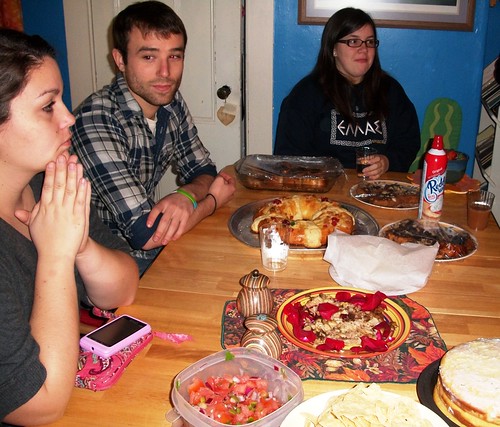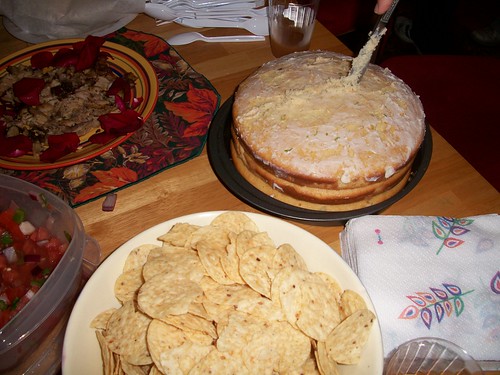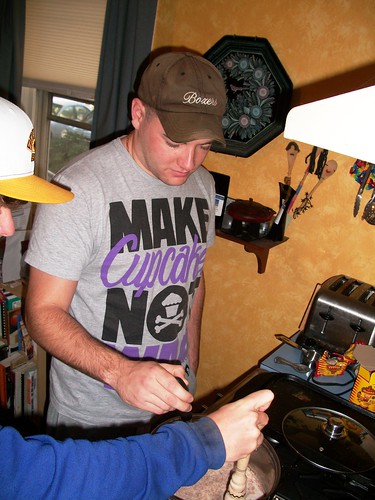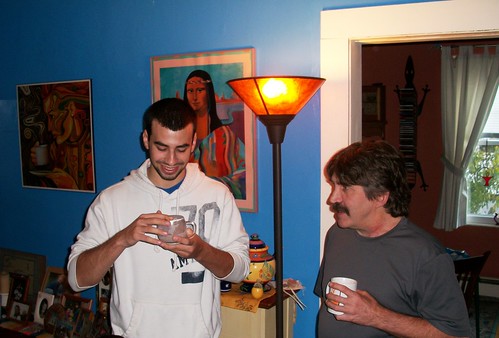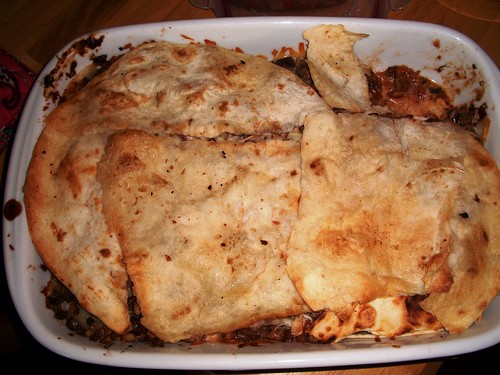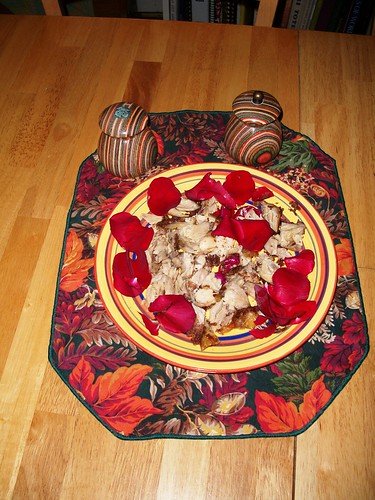 |
| photograph by James Hayes-Bohanan |
After watching the movie Like Water for Chocolate, Ross and I got a good grasp on what type of dish we wanted to make. In the movie, Tita’s cooking was made from pure love and whoever ate her creations felt the same emotions as she did. This was something that we wanted to try for ourselves. We wanted this dish to be challenging and creative so we could try new things and learn something new. It did not take us that long to decide that we wanted to prepare a dish called quail in rose petal sauce. This dish was in the movie and in a way set the mood to the main theme of the movie. This dish was the most powerful of all foods in the movie and without it true love would never be the same. There were other scenes in the movie that were extremely romantic, which contributed to what we wanted to create. Sparks of romance filled the air, even though sometimes it was unseen.
Magic realism played a huge role in this movie, especially for Tita and Pedro. The main theme of the movie dealt with two lovers who could not be together. The main woman in the movie, Tita, was the youngest in the family. Tradition in their family was very precise and since Tita was the youngest, she was the one who had to take care of her mother. As Tita began to take care of her mother, she cooked many dishes with each one having their own significance.
There are many different historical myths about roses but there was one that struck our eyes. In Greek Mythology the goddess of flowers, Chloris, created the roses while Aphrodite gave the rose its unique name. One day while Chloris was cleaning in the forest she found the lifeless body of a beautiful nymph. To right this wrong Chloris enlisted the help of Aphrodite, the goddess of love, who gave her beauty; then called upon Dionysus, the god of wine, who added nectar to give her a sweet scent. When it was their turn the three Graces gave Chloris charm, brightness and joy. Then Zephyr, the West Wind, blew away the clouds so that Apollo, the sun god, could shine and make the flower bloom.
In a Teutonic myth, fairies and dwarves protected the roses. If someone wanted to pick up roses they would have the ask permission from the fairies and dwarves. Another interesting thing we found is that in the Middle Ages they brewed the roses into a drink. When people took a sip of the drink they had illusions of fairies and believed that they could really see them.
Both these myths relate to the movie in many ways. They both relate to Tita and her mother. Like the Teutonic myth, Tita had to ask permission to do anything she wanted. Also, there is a scene in the movie when Tita sees her dead mother’s spirit, which creates an illusion. In the myth of Greek Mythology Tita used roses and honey (nectar) to create her romantic dish. The dish also showed the true beauty of Tita and how her dishes can tap into people’s emotions.
Roses were the main topic in our research and there were a lot of things that neither of us knew about. There are many types of roses that range in color and each color is symbolic. In some countries roses symbolized the transition of life and death. Many roses were placed on graves for the sake of loved ones and helped them balance the effects of losing a loved one. For our dish we chose red roses, which symbolize respect and love. It poses an image of romance and how the true meaning of the word love still exists in the body and mind. The rose originated in Persia and was used mainly for medicine and for cooking. In medicine, the rose was used somewhat as a vitamin capturing Vitamin C which had more of an effect than eating an orange. As for food, all the different parts of the rose were used for soups, teas, deserts, etc. There was an interesting folktale we found that said people were placed under magic spells and turned into animals. But once they ate some roses they turned back into their human form. There is a lot of significance about roses and their sense of magical mystery.
We took our ingredients and split them in half so we could each make our own recipe. For Hailee, she first started to prepare the recipe at her home. She took the rose petals, almonds, and garlic cloves and put them into the blender. At first Hailee and her mom tried to cut the rose petals into small pieces but that did not work. Then they tried putting the rose petals into a cutter and that also did not work. So then Hailee and her mom decided to just throw everything into the blender and hope that it would work. Even putting it in the blender was a struggle. We had to put little amounts of the mixture and let the blender do the work. Once that was done we had to keep on adding the mixture until everything was blended. It was a long process and the roses were the hardest part of the recipe. After the roses, garlic, and almonds were mixed and grinded Hailee went to her older sister Ashley’s house to finish the rest of the dish. It was Ashley’s birthday so all of her family went to Ashley’s house. Hailee decided to make the dish there so everyone could try it and give feedback on it.
The rest of the process was a breeze. There were some minor adjustments for both our recipes. Instead of using quail like in the movie, we used chicken. Not that many like quail so we decided that mostly everyone likes chicken and that is what we should use. Another ingredient we did not use was the chestnuts. Somehow the ingredient list told us to use them but in the actual directions it never told us to incorporate the chestnuts into the recipe. Other than that we used everything else. No adjustments were made in the directions of the recipe and we followed it step by step. The only complication was that the chicken had to be cooked for an hour and a half instead of what the directions said: twenty minutes. The prep time for this dish was about an hour long while the cooking took an hour and a half.
As for Ross, Ross’s grandmother did all the cooking. He knows how good of a cook his grandmother was and he didn’t want to mess that up. Ross’s process was very similar to Hailee’s. The only difference was that his grandmother is an experienced cook so she did not have all the trouble of grinding the roses, garlic, and almonds. The process for his grandmother was quick and easy. They both had a fun time making this dish and so did Hailee and her family. This dish brought both the families closer drawing in the love. Personally we think the roses had an impact on the way we cooked and how it brought the families together.
The actual tasting of the food was our favorite part. Even though Ross and I divided our part of the dish, we both enjoyed the tasting part. At first we were both scared and did not know what to expect. We did not know how roses were going to taste and how roses would actually infuse the chicken with flavor. We expected it to taste bad and crunchy. We never knew that the roses would have such a significant impact on the chicken. At this moment, we were both very anxious to try our new and unique creations.
As we tasted our creations, our faces were loaded with emotions.Ross thought it was really good and felt a sense of the love his grandmother put into the cooking. As for Hailee this was a new experience because she never really cooked an actual meal before. Hailee thought the taste was new and exciting with flavor just like Ross did. The only thing different was Hailee thought the sauce on top of the chicken was a little too crunchy partly because the roses never literally infused into the chicken.
Overall, the dish was exquisite and even looked romantic. We both had an amazing experience with this project and we cannot wait until everybody tries our creation. Maybe you will also feel the sense of romance and passion while coming together as a big happy family.
Works Cited
Andrews, Tamra. Nectar & Ambrosia: an Encyclopedia of Food in World Mythology.
Santa Barbara, CA: ABC-CLIO, 2000. Print.
"Flowers, edible." The New Food Lover's Companion, Barron's. Hauppauge: Barron's
Educational Series, 2007. Credo Reference. Web. 08 November 2011.
Educational Series, 2007. Credo Reference. Web. 08 November 2011.
Like Water for Chocolate Como Agua Para Chocolate. Dir. Alfonso Arau. Perf. Marco
Leonardi, Lumi Cavazos and Regina Torné. Miramax, 1992. Videocassette.
"Like Water for Chocolate Rose Quail Recipe." TheRomantic.com: 1000s of Creative
Romantic Ideas and Free Expert Advice on Love, Relationships, Sex, Kissing,
Dating and Romance. Web. 17 Nov. 2011.
"The Cultural Meanings of Different Rose Colors." Home & Garden Ideas. Web. 08 Nov.
2011.
colors>.

